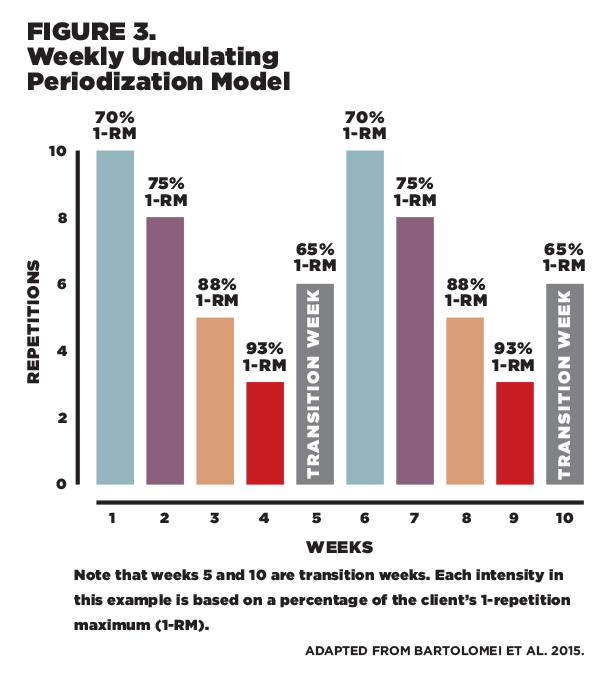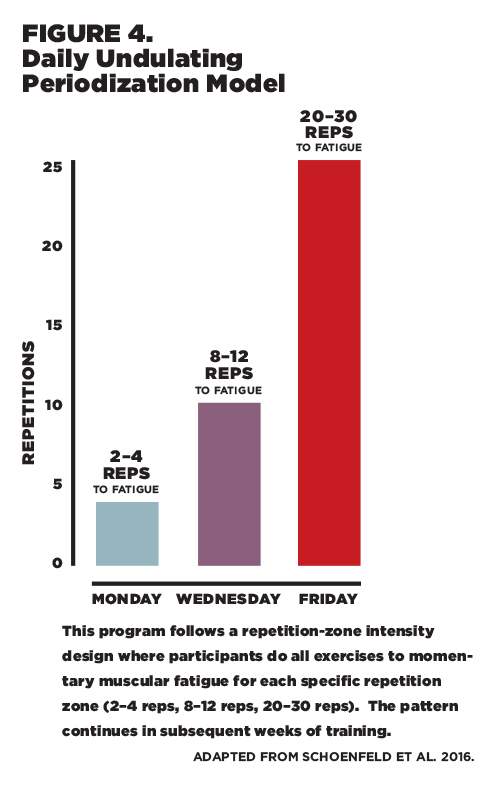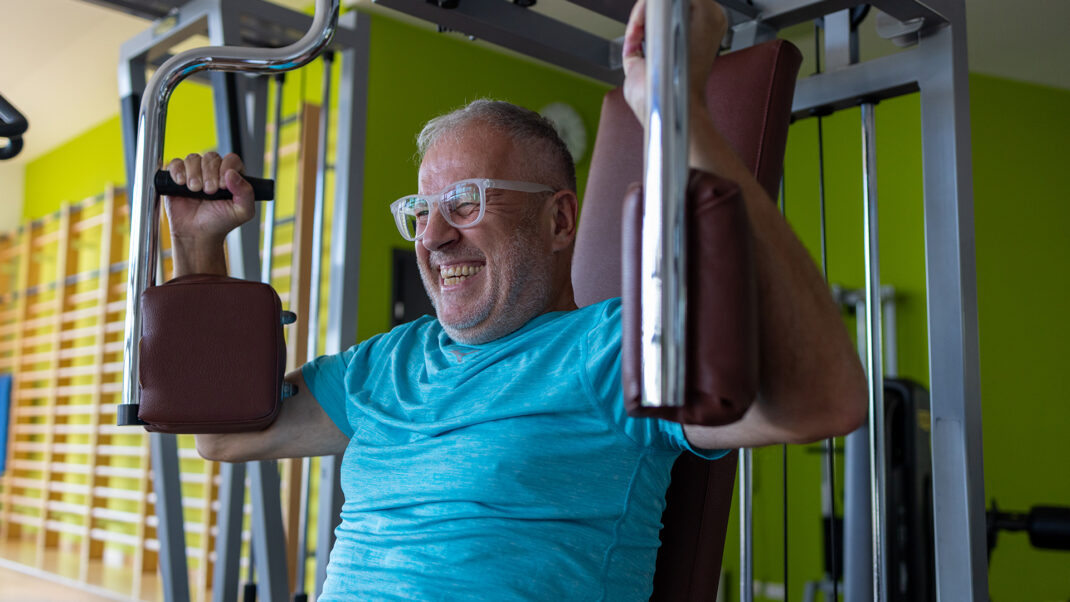Types of Periodization Training

Resistance training programs consist of numerous variables, including volume, intensity, frequency, rest intervals, exercise selection and exercise order (Williams et al. 2017). Periodization training is defined as a planned, cyclical (i.e., the program repeats) manipulation of the resistance training variables to attain peak performance at specific times of the year (Evans 2019).
Researchers have focused their investigations primarily on three types of commonly employed periodization types, which are explored below: linear periodization, block periodization and undulating periodization.
Linear Periodization Training
Linear periodization (LP) is a training strategy that starts with high volume and low intensity and then progresses to low volume and high intensity (Grgic et al. 2017). LP was introduced in the late 1950s by Russian professor Lev Matveev and is also referred to as traditional periodization (TP) in the literature (Kok, Hamer & Bishop 2009; Bartolomei et al. 2014). With LP, exercisers gradually increase the intensity of load as the program progresses while simultaneously decreasing the volume (see Figure 1).
Theoretically, the initial high-volume phase emphasizes hypertrophic adaptations, and the later high-intensity period challenges the neural mechanisms in the body (Kok, Hamer & Bishop 2009). Note in Figure 1 how training technique specificity increases in parallel with training intensity in the LP model. Certainly, LP program designs vary among personal trainers, but it’s common to make changes to volume and intensity every 4 weeks (Grgic et al. 2017).
Block Periodization Training
Block periodization (BP) is made up of several mesocycles, each with a concentrated training stimulus for a specific aspect of performance (Bartolomei et al. 2014) (see Figure 2). Each mesocycle—or block of time—prepares clients for the next cycle. For sport applications, mesocycles are arranged into three categories: accumulation, transformation and realization (Issurin 2010). The BP training methodology was introduced in the mid-1980s by Russian scientist Yuri Verchosanskij to meet the changing needs of athletes (Bartolomei et al. 2014).
Conventionally, the accumulation block focuses primarily on general aerobic endurance, basic muscle strength and foundational movement techniques (Issurin 2010). During the transformation block, the athlete performs specialized muscle-conditioning exercises and practices sport-specific techniques (Issurin 2010). Last, the realization block is a pre-competition training phase focusing on attaining maximal speed and performance. Each block lasts 2–4 weeks, depending on the program duration and the client’s specific goals (Issurin 2010).
See also: Using Periodization to Promote Optimal Recovery
Undulating Periodization Training
Undulating periodization (UP) involves frequent alterations of volume and intensity within a training program; these alterations often occur weekly (WUP) and/or daily (DUP) (Evans 2019) (see Figures 3 and 4 for daily and weekly undulating periodization models). During a WUP program, exercisers cycle through weeks of light-, moderate- and high-intensity training. During DUP, these intensities vary from day to day. Practically speaking, a client in a DUP program may do a hypertrophy workout, a strength workout and a power workout within 1 week.
Evans summarizes research indicating that UP programs are likely the best choice for developing strength in RT programs. McNamara & Stearne (2010) submit that undulating programs are also advantageous because the design helps to prevent overtraining and mental boredom while also being easily adaptable to a client’s travel schedule. The frequent changes of volume and intensity in UP programs may induce larger neural adaptations, while concomitantly counteracting fatigue (Pelzer, Ullrich & Pfeiffer 2017). The term undulating refers to the “wave form” representation of intensities when graphed.
Unique Advantages of Periodization
- Lifting within the same intensity zone over time may lead to stagnation in results (Turner 2011). A periodized program prevents stagnation by continually overloading the neuromuscular system with varying intensities.
- Continual training with primarily heavy loads may lead to undue fatigue, overtraining and soft-tissue injury (Turner 2011; Williams et al. 2017). Periodized plans undulate through periods of low, moderate and high volume and intensity to prevent overtraining and performance decrements.
- In accordance with the S.A.I.D principle (specific adaptations to imposed demands), periodized plans allow personal trainers and their clients to program for a variety of specific training outcomes.
- Brand-new research demonstrates that low-intensity RT (30% of 1-RM) improves the quality and quantity of mitochondria (i.e., the ATP production organelles of cells) (Lim et al. 2019). Thus, intentionally including blocks of low intensity will also improve the aerobic capacity of skeletal muscle fibers.
- Periodized programs easily allow personal trainers to program low-volume tapering and de-loading
weeks to promote recovery and allow for neuromuscular adaptations (Turner 2011). - Periodization plans let personal trainers plan for phases of overreaching (brief microcycles in which volume and/or intensity are ramped up to deliver a strong stimulus for adaptation).
See also: Periodization for Maximizing Hypertrophy
References
Bartolomei, S., et al. 2014. A comparison of traditional and block periodized strength training programs in trained athletes. Journal of Strength and Conditioning Research, 28 (4), 990–97.
Evans, J.W. 2019. Periodized resistance training for enhancing skeletal muscle hypertrophy and strength: A mini-review. Frontiers in Physiology, 10 (13), 1–7.
Grgic, J., et al. 2017. Effects of linear and daily undulating periodized resistance training programs on measure of muscle hypertrophy: A systematic review and meta-analysis. PeerJ, 5:e3695: doi:10.7717/peerj.3695.
Issurin, V.B. 2010. New horizons for the methodology and physiology of training periodization. Sports Medicine, 40 (3), 189–206.
Kok, L.Y., Hamer, P.W., & Bishop, D.J. 2009. Enhancing muscular qualities in untrained women: Linear versus undulated periodization. Medicine & Science in Sports & Exercise, 41 (9), 1797–1807.
Lim, C., et al. 2019. Resistance exercise-induced changes in muscle metabolism are load-dependent. Medicine & Science in Sports & Exercise, 51 (12), 2578–85.
McNamara, J.M., & Stearne, D.J. 2010. Flexible nonlinear periodization in a beginner college weight training class. Journal of Strength and Conditioning Research, 24 (8), 2012–17.
Pelzer, T., Ullrich, B., & Pfeiffer, M. 2017. Periodization effects during short-term resistance training with equated exercise variables in females. European Journal of Applied Physiology, 117, 441–54.
Turner, A. 2011. The science and practice of periodization: A brief review. Strength and Conditioning Journal, 33 (1), 34–46.
Williams, T.D., et al. 2017. Comparison of periodized and non-periodized resistance training on maximal strength: A meta-analysis. Sports Medicine, 47 (10), 2083–2100.
Len Kravitz, PhD
Len Kravitz, PhD is a professor and program coordinator of exercise science at the University of New Mexico where he recently received the Presidential Award of Distinction and the Outstanding Teacher of the Year award. In addition to being a 2016 inductee into the National Fitness Hall of Fame, Dr. Kravitz was awarded the Fitness Educator of the Year by the American Council on Exercise. Just recently, ACSM honored him with writing the 'Paper of the Year' for the ACSM Health and Fitness Journal.
Zachary Mang, PhD
Zachary Mang, PhD, is a postdoctoral research associate for the wellness program at the Los Alamos National Lab where he specializes in strength and conditioning for structural firefighters. His research interests include resistance training for hypertrophy, oxidative adaptations to resistance training, and the use of resistance training as a frontline defense to prevent chronic disease.











